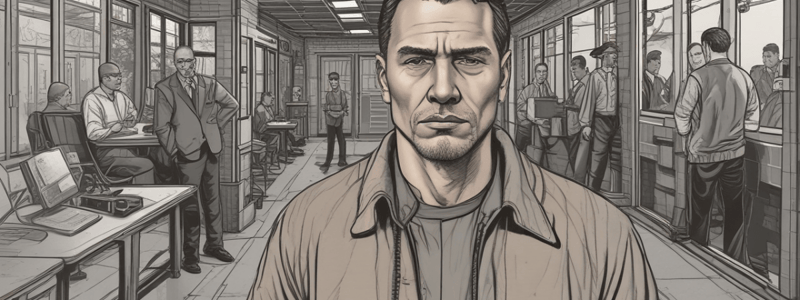Podcast
Questions and Answers
What was the primary method of assessing offender risk during the first half of the twentieth century?
What was the primary method of assessing offender risk during the first half of the twentieth century?
- Evidence-based tools
- Actuarial risk assessment
- Clinical assessments
- Professional judgement (correct)
Which model emphasizes evidence-based science over professional judgement for assessing offender risk?
Which model emphasizes evidence-based science over professional judgement for assessing offender risk?
- First-generation model
- Probation model
- RNR model
- Second-generation model (correct)
What distinguishes actuarial risk assessment instruments from professional judgement in assessing offender risk?
What distinguishes actuarial risk assessment instruments from professional judgement in assessing offender risk?
- Reliance on scientific evidence (correct)
- Reliance on subjective opinions
- Reliance on experience
- Reliance on intuition
In what decade did the shift towards evidence-based tools for assessing offender risk begin?
In what decade did the shift towards evidence-based tools for assessing offender risk begin?
What is the main focus of actuarial risk assessment instruments?
What is the main focus of actuarial risk assessment instruments?
Which group primarily made judgements about enhancing security and supervision based on their professional training and experience?
Which group primarily made judgements about enhancing security and supervision based on their professional training and experience?
What was the main focus of the RNR model in relation to offender rehabilitation programs?
What was the main focus of the RNR model in relation to offender rehabilitation programs?
Why did the second generation shift towards using evidence-based tools for assessing offender risk?
Why did the second generation shift towards using evidence-based tools for assessing offender risk?
What is recommended if the offender has limited verbal skills and a concrete thinking style?
What is recommended if the offender has limited verbal skills and a concrete thinking style?
Why is it important to provide child care for women offenders attending treatment?
Why is it important to provide child care for women offenders attending treatment?
What should be included along with structured cognitive behavioral treatment for Aboriginal offenders?
What should be included along with structured cognitive behavioral treatment for Aboriginal offenders?
Which risk factor should be considered during offender assessment?
Which risk factor should be considered during offender assessment?
What does the LS/CMI assessment instrument have a separate section on?
What does the LS/CMI assessment instrument have a separate section on?
What is the main flaw in focusing only on differentiating low risk from high-risk offenders?
What is the main flaw in focusing only on differentiating low risk from high-risk offenders?
What does second-generation risk scales primarily focus on?
What does second-generation risk scales primarily focus on?
Why is it considered short-sighted to focus only on differentiating between low risk and high-risk offenders?
Why is it considered short-sighted to focus only on differentiating between low risk and high-risk offenders?
What are the possibilities regarding an individual's risk level in third-generation risk assessment instruments?
What are the possibilities regarding an individual's risk level in third-generation risk assessment instruments?
In third-generation risk assessment, what type of items are included in addition to criminal history and past substance abuse?
In third-generation risk assessment, what type of items are included in addition to criminal history and past substance abuse?
What is a significant difference between second and third generation risk assessment instruments?
What is a significant difference between second and third generation risk assessment instruments?
Why were criminal history items considered important in third-generation risk assessment instruments?
Why were criminal history items considered important in third-generation risk assessment instruments?
Which statement accurately reflects the development of risk assessment instruments according to the text?
Which statement accurately reflects the development of risk assessment instruments according to the text?
What distinguishes third-generation risk assessment instruments from earlier generations?
What distinguishes third-generation risk assessment instruments from earlier generations?
Why is it important for third-generation risk assessments to include items on present employment and family relationships?
Why is it important for third-generation risk assessments to include items on present employment and family relationships?
What did third-generation risk assessment instruments aim to address that was lacking in second-generation tools?
What did third-generation risk assessment instruments aim to address that was lacking in second-generation tools?
What is a specific intervention goal for individuals with an antisocial personality pattern?
What is a specific intervention goal for individuals with an antisocial personality pattern?
Which risk/need factor involves replacing procriminal friends with prosocial friends?
Which risk/need factor involves replacing procriminal friends with prosocial friends?
What is a common indicator of a lack of involvement in prosocial recreational activities?
What is a common indicator of a lack of involvement in prosocial recreational activities?
Which risk/need factor involves enhancing work/study skills and nurturing interpersonal relationships?
Which risk/need factor involves enhancing work/study skills and nurturing interpersonal relationships?
What is a recommended goal for individuals with poor feelings of self-esteem and self-worth?
What is a recommended goal for individuals with poor feelings of self-esteem and self-worth?
Which risk/need factor involves reducing substance abuse and enhancing alternatives to substance use?
Which risk/need factor involves reducing substance abuse and enhancing alternatives to substance use?
What is a goal for individuals with inappropriate parental monitoring and disciplining?
What is a goal for individuals with inappropriate parental monitoring and disciplining?
What aspect of the theory focuses on deliberate self-regulation and the importance of procriminal attitudes in causing criminal behavior?
What aspect of the theory focuses on deliberate self-regulation and the importance of procriminal attitudes in causing criminal behavior?
Which part of the GPCSL theory underscores learning within social contexts like family, school, and work?
Which part of the GPCSL theory underscores learning within social contexts like family, school, and work?
What is assessed within social contexts to provide a comprehensive survey of criminogenic needs and strengths?
What is assessed within social contexts to provide a comprehensive survey of criminogenic needs and strengths?
Which term refers to the risk factors linked to criminal behavior, as per the GPCSL perspective?
Which term refers to the risk factors linked to criminal behavior, as per the GPCSL perspective?
Which model is subsumed under the GPCSL perspective, expected to be relevant across a range of offenders?
Which model is subsumed under the GPCSL perspective, expected to be relevant across a range of offenders?
What does the GPCSL perspective aim to direct services towards, based on an assessment of the 'central eight'?
What does the GPCSL perspective aim to direct services towards, based on an assessment of the 'central eight'?
Flashcards are hidden until you start studying



